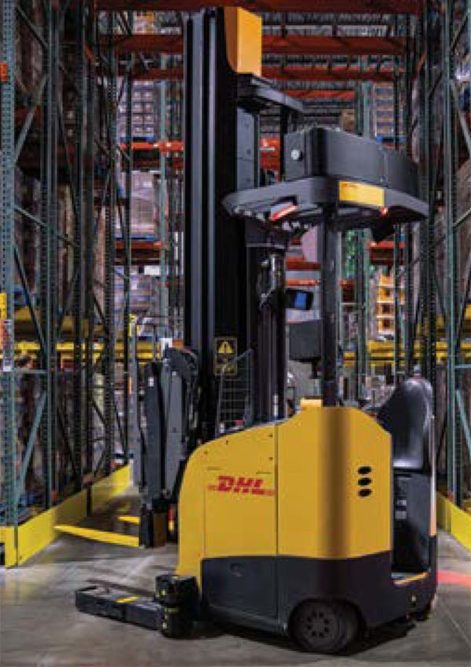The high-tech warehouse takes shape
From autonomous forklifts to smart sorting robots, emerging technologies are taking hold throughout the warehouse as logistics services providers seek to boost productivity, improve safety, and respond to labor shortages.

It’s high time for high technology.
As logistics services providers struggle with accelerating consumer demand, sluggish supply lines, and labor challenges, many are moving beyond the exploratory phase of automating their warehouses and are putting systems to work. A Gartner survey of more than 500 supply chain professionals bears this out: 96% of respondents polled for its 2020 Gartner Supply Chain Technology User Wants and Needs survey said they had used or plan to use cyber-physical automation in their warehousing and manufacturing operations. These are highly automated, intelligent systems that integrate physical and software components—robotic systems are a good example. Looking ahead, the report suggests nearly every warehouse will be using a robot in some way within the next decade.
Many are already well on their way to achieving that goal. Here’s a look at how a handful of companies are using cyber-physical automation to address efficiency and labor challenges.
AUTONOMOUS FORKLIFTS IN ACTION
Contract logistics specialist DHL Supply Chain is one example of a company moving full-steam ahead to implement cyber-physical solutions. The company started to explore autonomous forklifts for its warehouses about four years ago and is now using them at locations across the U.S. The effort is part of a plan to implement a range of automated warehouse technologies, including various autonomous vehicle solutions, and serves as an example of how the company is putting some of the latest tech to work. Its autonomous high-reach fork trucks are doing 100% of pallet putaway and picking at some locations, controlled by each facility’s warehouse management system (WMS).
“[These are] fully autonomous solutions integrated with our WMS,” explains Brian Gaunt, a senior director who is responsible for innovation and robotics for DHL Supply Chain in North America. The system automates the challenging task of manually running a high-reach fork truck—which requires considerable training to operate safely and effectively. The system is helping to improve productivity while also addressing labor and safety issues, he says.
“In a challenging labor market, you can’t just hire anyone and have them do this task,” Gaunt adds. “We like to think that these systems are also making it safer in that they are taking these more challenging movements and doing them [without human intervention].”
The autonomous forklift project began as a larger testing program designed to address pallet movement in the warehouse. Looking to improve upon that process, company leaders began by investigating a range of solutions and vendors—including, but not limited to, autonomous equipment; determined where they might find the greatest value; tested some solutions; and then rolled out what worked best, where it made the most sense. The autonomous high-reach fork trucks turned out to be a prime solution for a number of locations.
“We really look at our warehouses as a series of use cases that we string together,” Gaunt says, explaining that managers may start with 20 possible use cases for pallet movement, but only end up testing and implementing a portion of them. “That’s the progression. It’s very much an iterative process.”
The autonomous forklift project will soon be rolled out on a larger scale.
“It takes a while to get familiar with [the system]. Now, we’re at a point where we’re comfortable with the handful we have, so we’re in the scaling mode, which is exactly where we want to be,” Gaunt says, adding that DHL plans to implement the forklifts at more locations nationwide.
SMART SORTING ROBOTS
Parcel carrier FedEx Ground is advancing with cyber-physical automation as well, with recent examples in New York, Ohio, and Nevada. Partnering with robotics firm Berkshire Grey, the company has implemented a robotic sortation solution for autonomous package processing—a move that’s in direct response to accelerated e-commerce activity.
The company is using Berkshire Grey’s Robotic Product Sortation and Identification (RPSi) system at a Queens, New York, facility to robotically sort the thousands of small packages that arrive daily in bulk into containers bound for other facilities across the FedEx Ground network. The artificial intelligence (AI)-based system autonomously picks, identifies, sorts, collects, and “containerizes” individual poly bags, tubes, padded mailers, and other small packages that have traditionally been sorted manually. The system requires fewer package handlers to operate, allowing FedEx to reallocate workers to other tasks in the facility. Other benefits include enhanced productivity, efficiency, and safety, as well as greater flexibility to adjust to changing package volumes and sizes, according to Ted Dengel, managing director of operations technology and innovation at FedEx Ground.
The system also addresses the tricky challenge of scanning labels. In traditional package sortation, workers have to position parcels so the label can be scanned properly. Berkshire Grey’s system uses technology that allows bar codes to be read from any angle in milliseconds, without manual intervention, according to Jessica Moran, the company’s senior vice president, parcels and 3PL businesses.
FedEx Ground’s success in Queens has prompted other implementations; the company was testing similar systems at sortation facilities in Columbus, Ohio, and Las Vegas this past fall.
SPEEDY ROBOTIC ASSISTANTS
Accelerating e-commerce was the driver for a similar sortation solution at Greek logistics and transportation services provider Athinaiki, S.A. Working with global autonomous mobile robot (AMR) developer Geek+ Robotics and systems integrator FDL, the company has deployed smart sorting robots in one of its e-commerce fulfillment warehouses, with the ultimate goal of speeding last-mile delivery to customers throughout Greece and Cyprus.
Set in a roughly 6,000-square-foot warehouse, 29 sorting robots help warehouse employees sort 1,400 to 1,500 parcels per hour. Employees put ordered goods onto sorting robots that automatically transfer the parcels to one of 104 sorting cages bound for different destinations. The AMRs travel freely through the warehouse, with no wires or fixed infrastructure, making it easy for Athinaiki to scale up or down to meet throughput demand by adjusting the number of robots and sorting destinations. The robots are controlled by a robot management system (RMS) and powered by algorithms, creating a solution that monitors robot traffic and balances each robot’s tasks to achieve maximum sorting efficiency and accuracy, according to Geek+ Robotics.
THE ROAD AHEAD
It won’t be long before some of the systems in place now will begin “thinking” for themselves. Among Gartner’s picks for top strategic technologies for 2022 are “autonomic” computing systems: self-managing physical or software systems that learn from their environments. As the company described it in a report this past October: “Unlike automated or even autonomous systems, autonomic systems can dynamically modify their own algorithms without an external software update, enabling them to rapidly adapt to new conditions in the field, much like humans can.”
The technology is already being used in complex security systems, Gartner says, and in the longer term will find its way into physical systems such as robots, drones, manufacturing machines, and smart spaces.
Related Articles

Copyright ©2024. All Rights ReservedDesign, CMS, Hosting & Web Development :: ePublishing